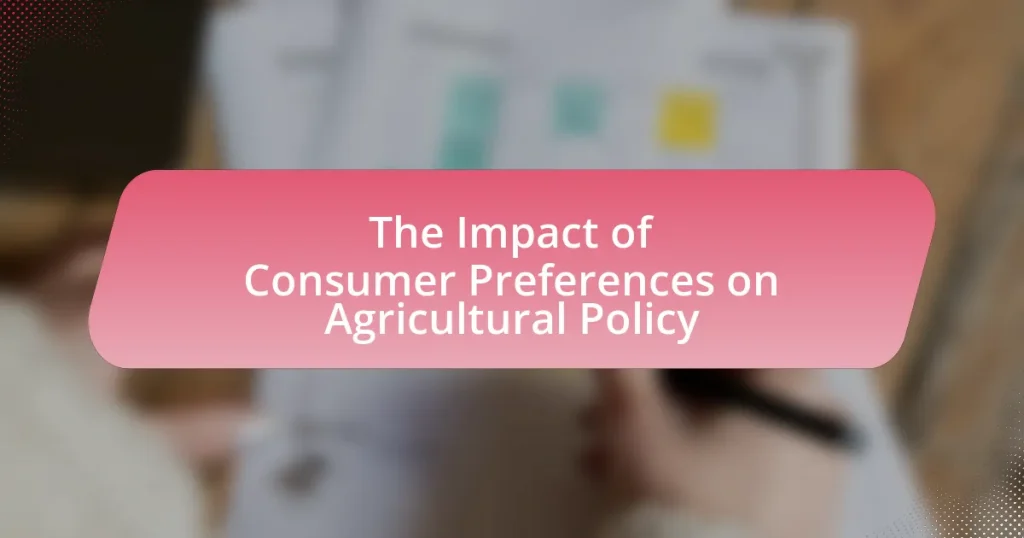The article examines the significant influence of consumer preferences on agricultural policy, highlighting how demand for organic, sustainable, and locally sourced foods shapes legislative frameworks and farming practices. It discusses the factors driving these preferences, including health consciousness, environmental concerns, and cultural values, and their impact on agricultural production and food security. Additionally, the article outlines key trends in consumer behavior, demographic variations, and the importance of aligning agricultural policies with consumer demands to promote sustainability and economic growth. Strategies for policymakers to effectively respond to shifting consumer preferences are also explored, emphasizing stakeholder engagement and data-driven approaches.

What is the Impact of Consumer Preferences on Agricultural Policy?
Consumer preferences significantly influence agricultural policy by shaping demand for specific products and practices. When consumers prioritize organic, sustainable, or locally sourced foods, policymakers often respond by implementing regulations and incentives that support these preferences. For instance, the rise in demand for organic produce has led to the establishment of certification programs and subsidies for organic farmers, as seen in the USDA’s National Organic Program. Additionally, consumer advocacy for animal welfare has prompted policies that enhance livestock living conditions, reflecting a shift towards more humane agricultural practices. These changes illustrate how consumer choices directly impact the legislative landscape governing agriculture.
How do consumer preferences shape agricultural policies?
Consumer preferences significantly shape agricultural policies by influencing the types of crops grown, farming practices adopted, and regulatory frameworks established. For instance, a growing demand for organic produce has led governments to implement policies that support organic farming through subsidies and certification programs. According to a report by the Food and Agriculture Organization, the global organic market reached $120 billion in 2019, prompting many countries to adjust their agricultural policies to accommodate this shift in consumer demand. Additionally, consumer preferences for sustainability have driven policies aimed at reducing pesticide use and promoting environmentally friendly farming practices, as seen in the European Union’s Green Deal, which aims to make food systems more sustainable.
What factors influence consumer preferences in agriculture?
Consumer preferences in agriculture are influenced by factors such as health consciousness, environmental concerns, price sensitivity, and cultural values. Health consciousness drives consumers to prefer organic and non-GMO products, as studies show that 70% of consumers are willing to pay more for organic foods due to perceived health benefits. Environmental concerns lead to a preference for sustainable farming practices, with 65% of consumers indicating they consider environmental impact when purchasing food. Price sensitivity affects choices, as consumers often prioritize affordability, especially in lower-income demographics, where price can be a decisive factor. Cultural values also shape preferences, as different communities may favor traditional or locally sourced foods, reflecting their heritage and identity. These factors collectively shape consumer behavior and, consequently, agricultural policy.
How do changing consumer preferences affect agricultural production?
Changing consumer preferences significantly affect agricultural production by driving shifts in crop selection, farming practices, and resource allocation. For instance, the rising demand for organic produce has led farmers to adopt organic farming methods, which often require different inputs and practices compared to conventional agriculture. According to the Organic Trade Association, organic food sales in the U.S. reached $61.9 billion in 2020, reflecting a 12.4% increase from the previous year. This shift in consumer preference not only influences what crops are grown but also impacts the entire supply chain, from seed selection to marketing strategies. Additionally, preferences for plant-based diets have prompted a surge in the production of legumes and vegetables, further altering traditional agricultural practices.
Why is understanding consumer preferences important for policymakers?
Understanding consumer preferences is crucial for policymakers because it directly influences the effectiveness of agricultural policies. Policymakers who grasp consumer preferences can tailor regulations and initiatives to meet the demands of the market, ensuring that agricultural products align with consumer expectations. For instance, a study by the Food and Agriculture Organization (FAO) highlights that consumer demand for organic products has surged, prompting policymakers to support organic farming practices to enhance market competitiveness. This alignment not only fosters economic growth but also promotes sustainable agricultural practices that resonate with consumer values.
What role do consumer preferences play in food security?
Consumer preferences significantly influence food security by shaping demand for various food products, which in turn affects agricultural production and distribution systems. When consumers prioritize certain attributes, such as organic or locally sourced foods, farmers and producers adjust their practices to meet these demands, impacting the availability and accessibility of food. For instance, a study by the Food and Agriculture Organization indicates that consumer demand for sustainable practices can lead to increased investment in environmentally friendly agricultural methods, thereby enhancing food security by ensuring a stable supply of food that meets quality standards.
How can policymakers respond to shifts in consumer demand?
Policymakers can respond to shifts in consumer demand by adjusting agricultural policies to align with emerging trends and preferences. For instance, when there is an increased demand for organic products, policymakers can incentivize organic farming through subsidies or grants, thereby encouraging farmers to transition to organic practices. Evidence from the USDA indicates that organic food sales have grown significantly, reaching $62 billion in 2020, which underscores the importance of aligning agricultural policy with consumer preferences. Additionally, policymakers can implement educational campaigns to inform consumers about sustainable practices, further driving demand for environmentally friendly products. This approach not only meets consumer needs but also supports agricultural sustainability and economic growth.

What are the key trends in consumer preferences affecting agriculture?
Key trends in consumer preferences affecting agriculture include a growing demand for organic products, increased interest in plant-based diets, and a focus on sustainability and ethical sourcing. Consumers are increasingly prioritizing health and environmental concerns, leading to a significant rise in organic food sales, which reached $61.9 billion in the U.S. in 2020, according to the Organic Trade Association. Additionally, the plant-based food market is projected to grow to $74.2 billion by 2027, reflecting a shift towards vegetarian and vegan diets. Furthermore, consumers are demanding transparency in food sourcing, prompting agricultural producers to adopt more sustainable practices to meet these preferences.
How do health and wellness trends influence agricultural policy?
Health and wellness trends significantly influence agricultural policy by shifting consumer demand towards healthier food options, prompting policymakers to adapt regulations and support for sustainable agricultural practices. For instance, the increasing preference for organic produce has led governments to implement standards and certifications that promote organic farming, as seen in the USDA’s National Organic Program. Additionally, the rise in demand for plant-based diets has encouraged agricultural policies to support the cultivation of legumes and vegetables, reflecting a broader trend towards reducing meat consumption for health benefits. These trends are backed by research indicating that consumers are willing to pay a premium for healthier food options, which in turn drives agricultural policy to align with these preferences.
What specific health trends are impacting food choices?
Specific health trends impacting food choices include the rise of plant-based diets, increased awareness of food allergies, and a focus on gut health. Plant-based diets have gained popularity due to their association with lower risks of chronic diseases, as evidenced by studies showing that vegetarian and vegan diets can reduce heart disease risk by up to 32%. Awareness of food allergies has led consumers to seek allergen-free options, with the market for gluten-free products growing significantly, projected to reach $7.59 billion by 2027. Additionally, the emphasis on gut health has driven interest in probiotics and fermented foods, supported by research indicating that gut microbiota plays a crucial role in overall health. These trends reflect a shift towards healthier eating habits that prioritize nutritional benefits and food safety.
How do these health trends affect agricultural practices?
Health trends significantly influence agricultural practices by driving demand for organic, non-GMO, and sustainably produced foods. As consumers increasingly prioritize health and wellness, farmers adapt by implementing practices that align with these preferences, such as reducing pesticide use and enhancing soil health. For instance, the organic food market has grown substantially, with sales reaching over $50 billion in the United States in 2019, prompting more farmers to transition to organic farming methods to meet consumer demand. This shift not only affects crop selection but also encourages the adoption of innovative farming techniques that promote biodiversity and environmental sustainability.
What is the impact of sustainability on consumer preferences?
Sustainability significantly influences consumer preferences by increasing demand for eco-friendly products. Research indicates that 66% of global consumers are willing to pay more for sustainable brands, reflecting a shift towards prioritizing environmental impact in purchasing decisions. This trend is driven by heightened awareness of climate change and environmental degradation, leading consumers to favor products that align with their values of sustainability. Additionally, brands that adopt sustainable practices often experience enhanced loyalty and trust from consumers, further solidifying the impact of sustainability on their preferences.
How do consumers define sustainability in agriculture?
Consumers define sustainability in agriculture as practices that promote environmental health, economic viability, and social equity. This definition encompasses methods that minimize negative impacts on ecosystems, such as reducing chemical inputs and conserving water, while also ensuring fair treatment and economic opportunities for farmers and workers. Research indicates that 66% of consumers consider sustainable farming practices important when making purchasing decisions, highlighting a growing preference for products that align with these values.
What policies are being implemented to promote sustainable practices?
Governments and organizations are implementing various policies to promote sustainable practices, including incentives for organic farming, regulations on pesticide use, and support for renewable energy in agriculture. For instance, the European Union’s Common Agricultural Policy includes measures that encourage environmentally friendly farming techniques and biodiversity conservation. Additionally, the U.S. Department of Agriculture offers grants and technical assistance for farmers transitioning to sustainable practices, which has been shown to increase the adoption of such methods. These policies aim to align agricultural practices with consumer preferences for sustainability, thereby enhancing environmental protection and food security.

How do consumer preferences vary across different demographics?
Consumer preferences vary significantly across different demographics, influenced by factors such as age, income, education, and cultural background. For instance, younger consumers tend to prioritize sustainability and organic products, while older demographics may focus more on price and convenience. Research from the Food Marketing Institute indicates that 60% of millennials are willing to pay more for sustainable products, compared to only 30% of baby boomers. Additionally, higher-income households often exhibit a preference for premium brands and specialty items, whereas lower-income consumers may prioritize affordability and basic necessities. These demographic differences shape agricultural policy by influencing demand for various food products, prompting policymakers to consider these preferences when developing regulations and support programs.
What demographic factors influence agricultural consumer choices?
Demographic factors that influence agricultural consumer choices include age, income, education level, and geographic location. Younger consumers tend to prioritize sustainability and organic products, while older consumers may focus on price and convenience. Higher income levels correlate with a preference for premium and organic products, as individuals with more disposable income are willing to pay extra for perceived quality. Education level also plays a role; consumers with higher education are often more informed about agricultural practices and may prefer products that align with their values, such as environmentally friendly options. Geographic location affects access to certain products and cultural preferences, influencing choices based on local agricultural practices and availability.
How do age and income levels affect food purchasing decisions?
Age and income levels significantly influence food purchasing decisions, as younger consumers tend to prioritize convenience and health, while older consumers often focus on quality and price. Research indicates that individuals aged 18-34 are more likely to purchase ready-to-eat meals and organic products, reflecting a preference for convenience and health-conscious choices. In contrast, consumers aged 55 and older typically exhibit a greater sensitivity to price and are more inclined to buy bulk items or store brands, as evidenced by a study from the USDA Economic Research Service, which found that higher income levels correlate with increased spending on premium food products. Additionally, lower-income households often prioritize basic nutritional needs, leading to a preference for cost-effective options. This demographic behavior shapes agricultural policy by influencing the types of products that farmers and producers focus on, ultimately affecting supply chains and market trends.
What cultural factors shape consumer preferences in agriculture?
Cultural factors that shape consumer preferences in agriculture include traditions, beliefs, values, and social norms. These elements influence dietary choices, perceptions of food quality, and preferences for local versus imported products. For instance, in many cultures, traditional foods are preferred due to their historical significance and perceived health benefits, which can lead to a higher demand for organic or locally sourced agricultural products. Additionally, cultural attitudes towards sustainability and environmental stewardship can drive consumers to favor agricultural practices that align with their values, such as organic farming or regenerative agriculture. Research indicates that consumers in regions with strong environmental movements are more likely to support sustainable agricultural policies, reflecting their cultural emphasis on ecological responsibility.
How do regional differences impact consumer preferences in agriculture?
Regional differences significantly impact consumer preferences in agriculture by influencing the types of crops grown, food production methods, and dietary habits. For instance, consumers in the Mediterranean region tend to prefer olive oil and fresh vegetables, while those in North America may favor corn and soybean products. This variation is often driven by local climate, cultural traditions, and economic factors. According to a study published in the Journal of Agricultural and Resource Economics, regional preferences can lead to distinct market demands, affecting agricultural policy decisions such as subsidies and trade regulations. These preferences shape not only what is produced but also how agricultural policies are formulated to meet the specific needs of different consumer bases.
What are the key regional variations in agricultural consumption?
Key regional variations in agricultural consumption include differences in dietary preferences, income levels, and cultural practices. For instance, in North America, high consumption of meat and processed foods contrasts with lower meat consumption and a focus on grains and legumes in regions like South Asia. Additionally, Europe exhibits a strong preference for organic products, influenced by environmental concerns, while Sub-Saharan Africa often relies on staple crops due to economic constraints. These variations are supported by data from the Food and Agriculture Organization, which highlights that regional income levels significantly affect food choices and consumption patterns, thereby impacting agricultural policies tailored to meet local demands.
How do local agricultural policies reflect consumer preferences?
Local agricultural policies reflect consumer preferences by aligning regulations and incentives with the demand for specific agricultural products and practices. For instance, policies promoting organic farming often arise in regions where consumers show a strong preference for organic produce, as evidenced by the increasing market share of organic products, which reached 5.8% of total U.S. food sales in 2021 according to the Organic Trade Association. Additionally, local governments may implement subsidies for sustainable farming practices in response to consumer demand for environmentally friendly products, demonstrating a direct correlation between consumer preferences and policy formulation.
What strategies can policymakers adopt to align agricultural policy with consumer preferences?
Policymakers can adopt strategies such as implementing consumer feedback mechanisms, promoting transparency in food labeling, and incentivizing sustainable agricultural practices to align agricultural policy with consumer preferences. By establishing platforms for consumer input, policymakers can gather data on preferences and trends, which can inform policy adjustments. For instance, studies show that 70% of consumers prefer products labeled as organic or sustainably sourced, indicating a strong market demand for transparency. Additionally, providing financial incentives for farmers who adopt environmentally friendly practices can encourage alignment with consumer values focused on sustainability. This approach not only meets consumer demand but also supports long-term agricultural viability.
How can stakeholder engagement improve policy effectiveness?
Stakeholder engagement can improve policy effectiveness by ensuring that diverse perspectives and needs are incorporated into the policy-making process. When stakeholders, such as farmers, consumers, and industry representatives, actively participate, policies are more likely to address real-world challenges and reflect the interests of those affected. Research indicates that inclusive engagement leads to higher compliance rates and better implementation outcomes, as stakeholders feel a sense of ownership over the policies. For instance, a study by the World Bank found that participatory approaches in agricultural policy development resulted in more sustainable practices and increased productivity, demonstrating the tangible benefits of stakeholder involvement in shaping effective policies.
What best practices can be implemented to adapt to consumer trends?
To adapt to consumer trends, businesses should implement data-driven market analysis to identify emerging preferences and behaviors. This practice enables companies to tailor their products and marketing strategies effectively. For instance, a report by McKinsey & Company highlights that organizations leveraging consumer data analytics can increase their revenue by up to 15% by aligning their offerings with consumer demands. Additionally, fostering direct communication channels with consumers, such as surveys and social media engagement, allows businesses to gather real-time feedback, ensuring they remain responsive to changing trends.















